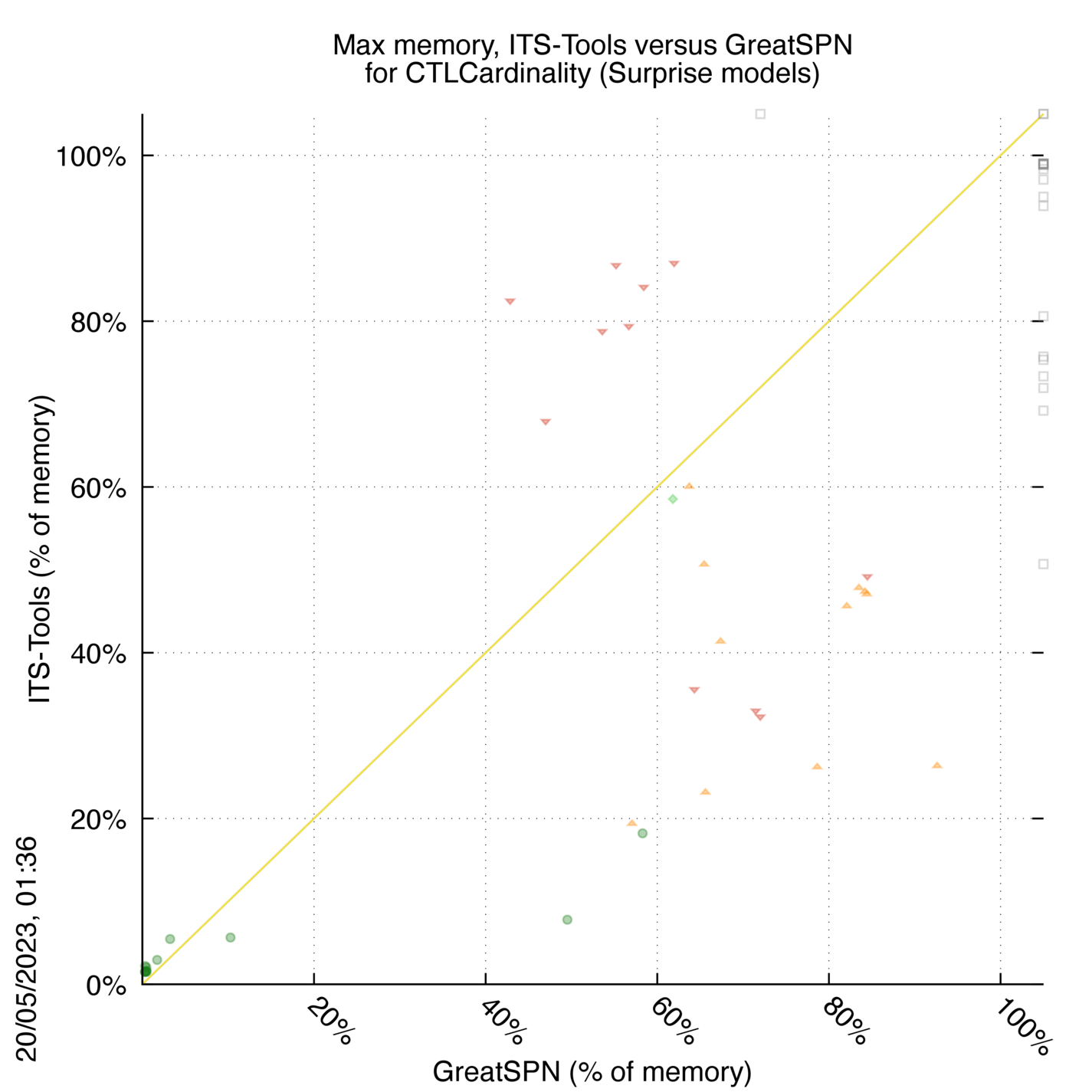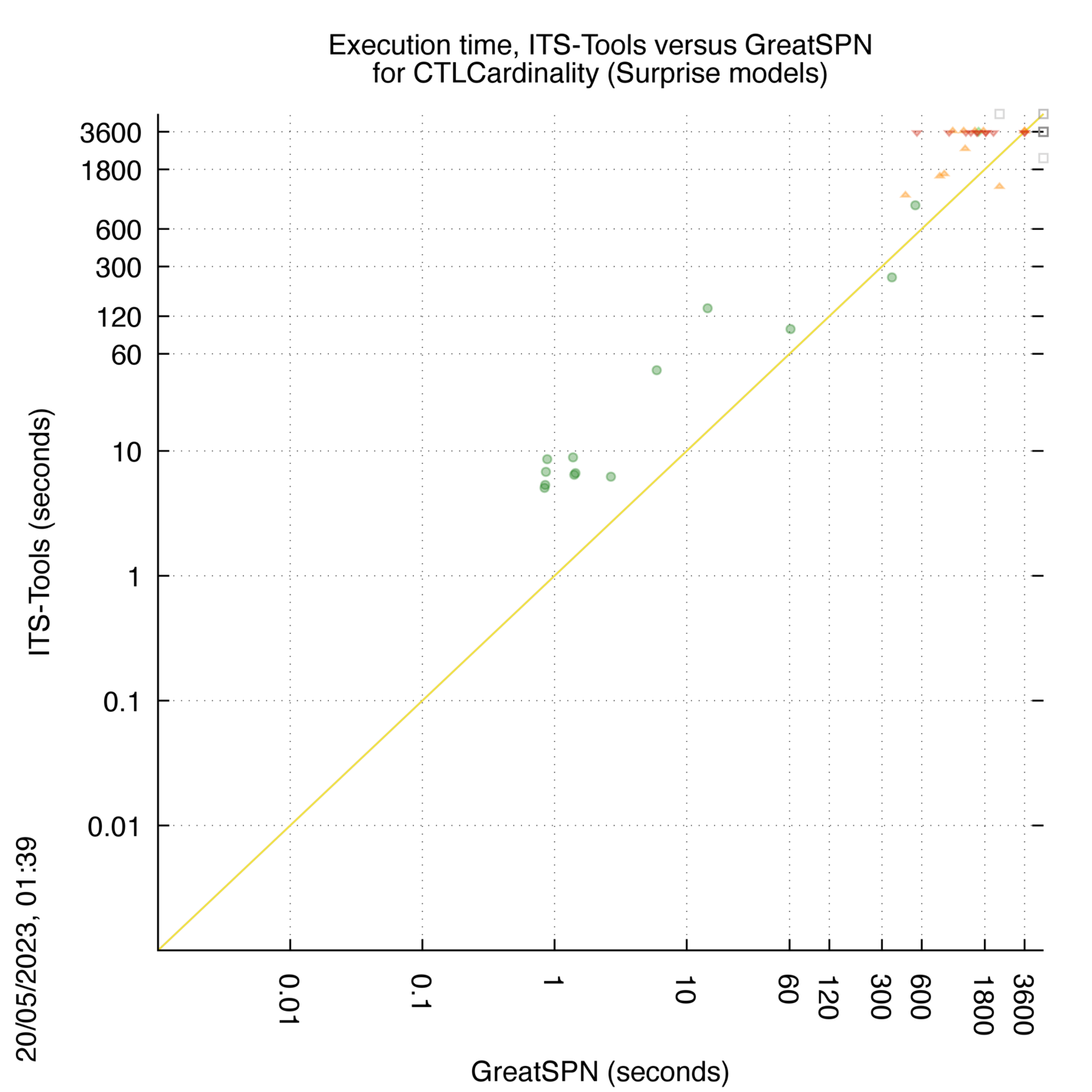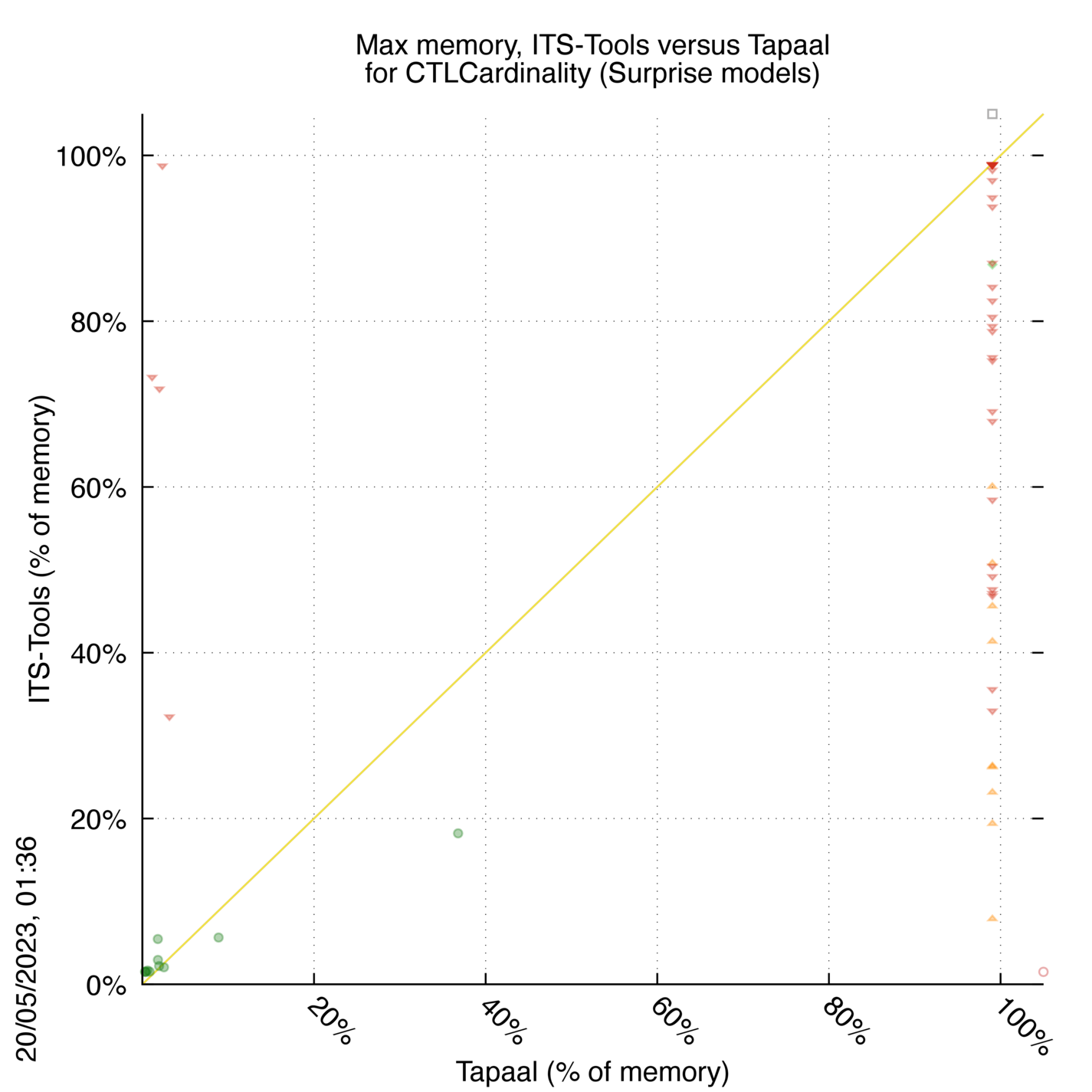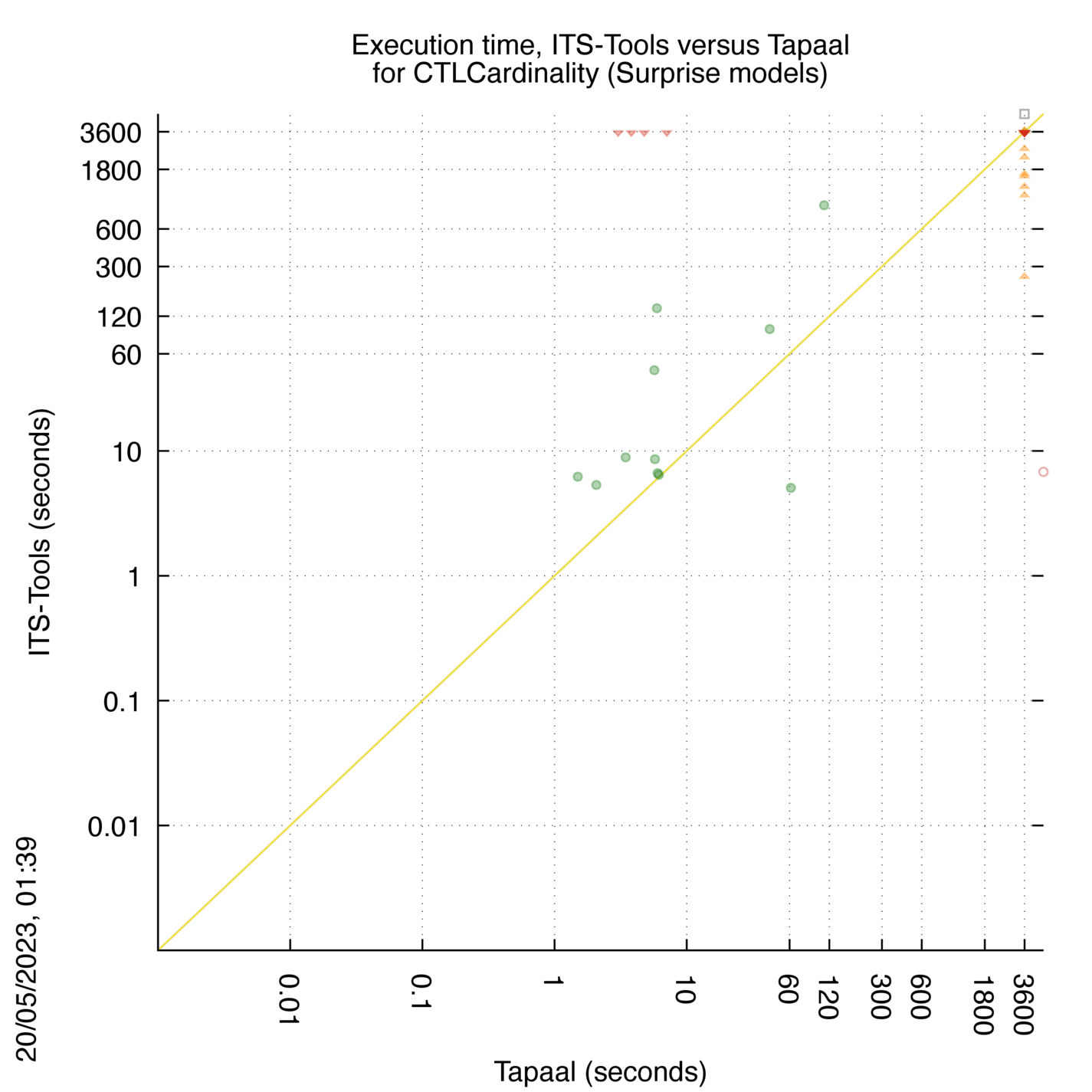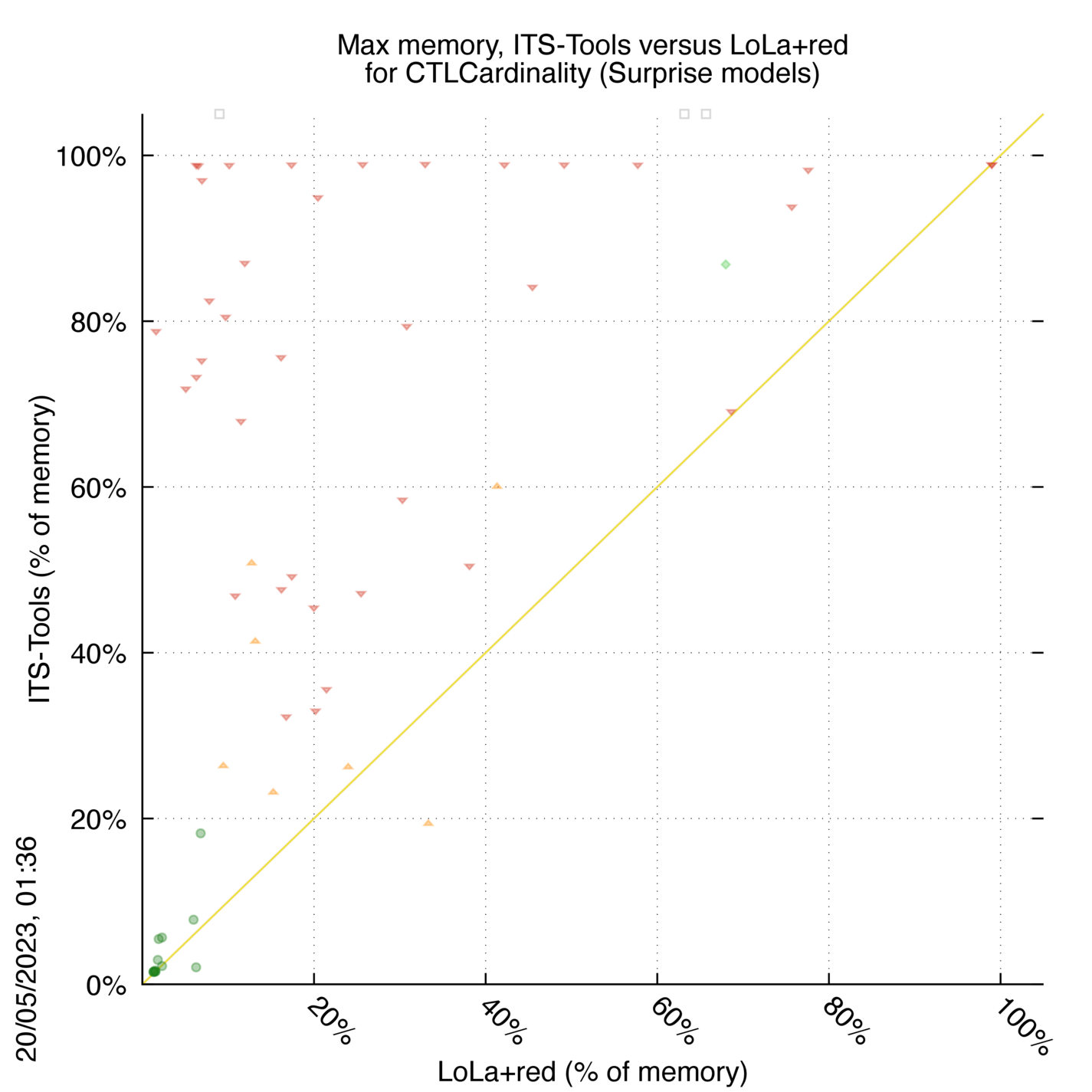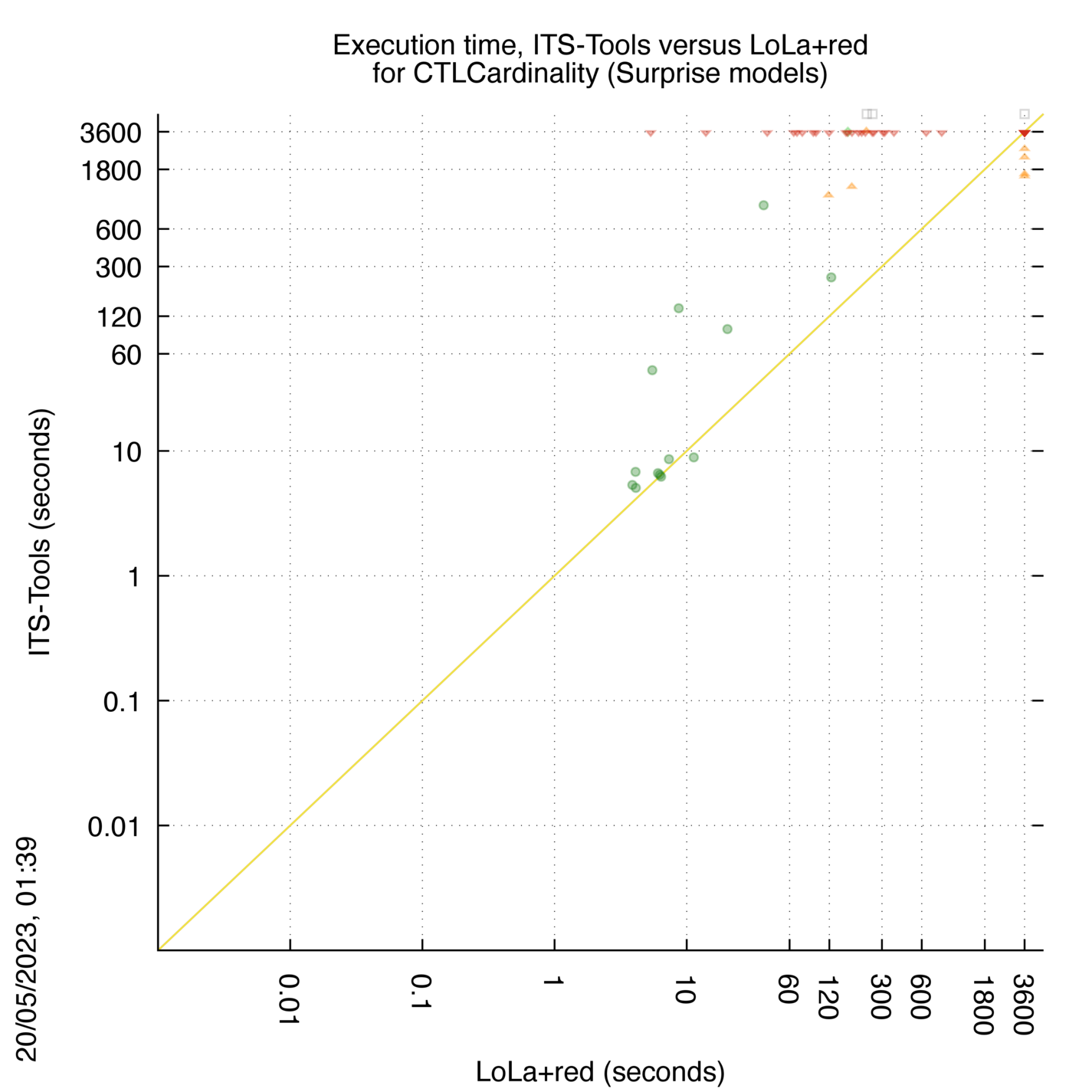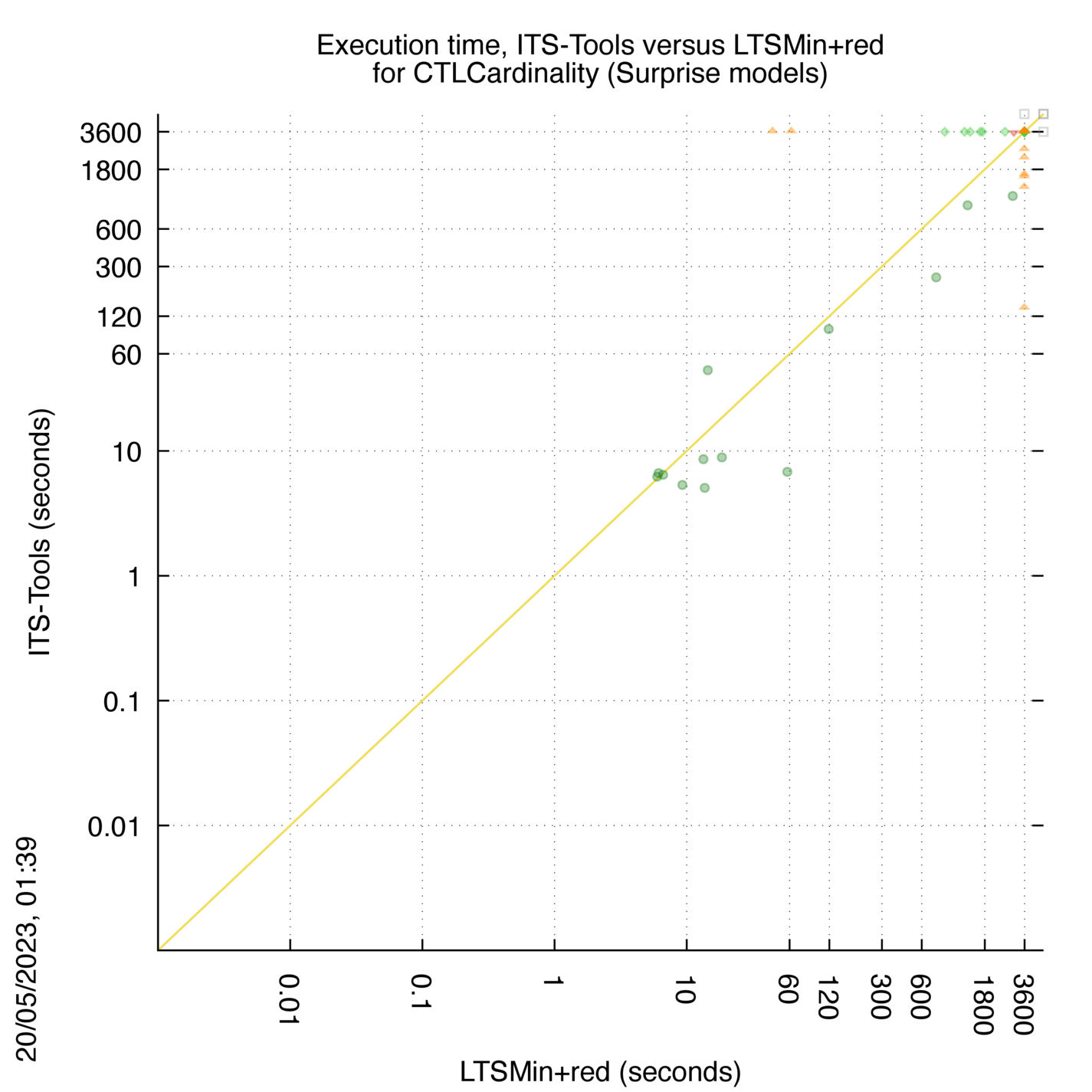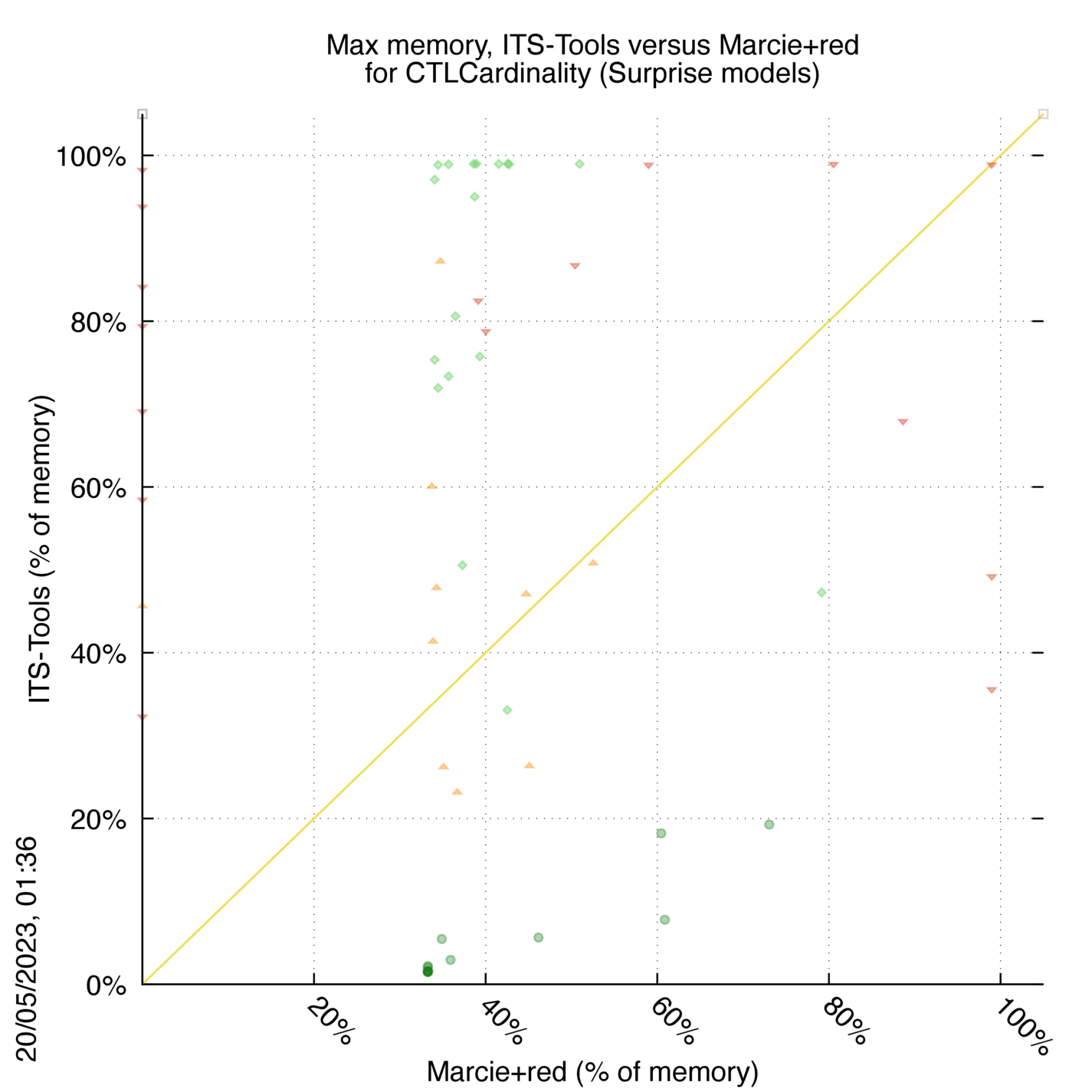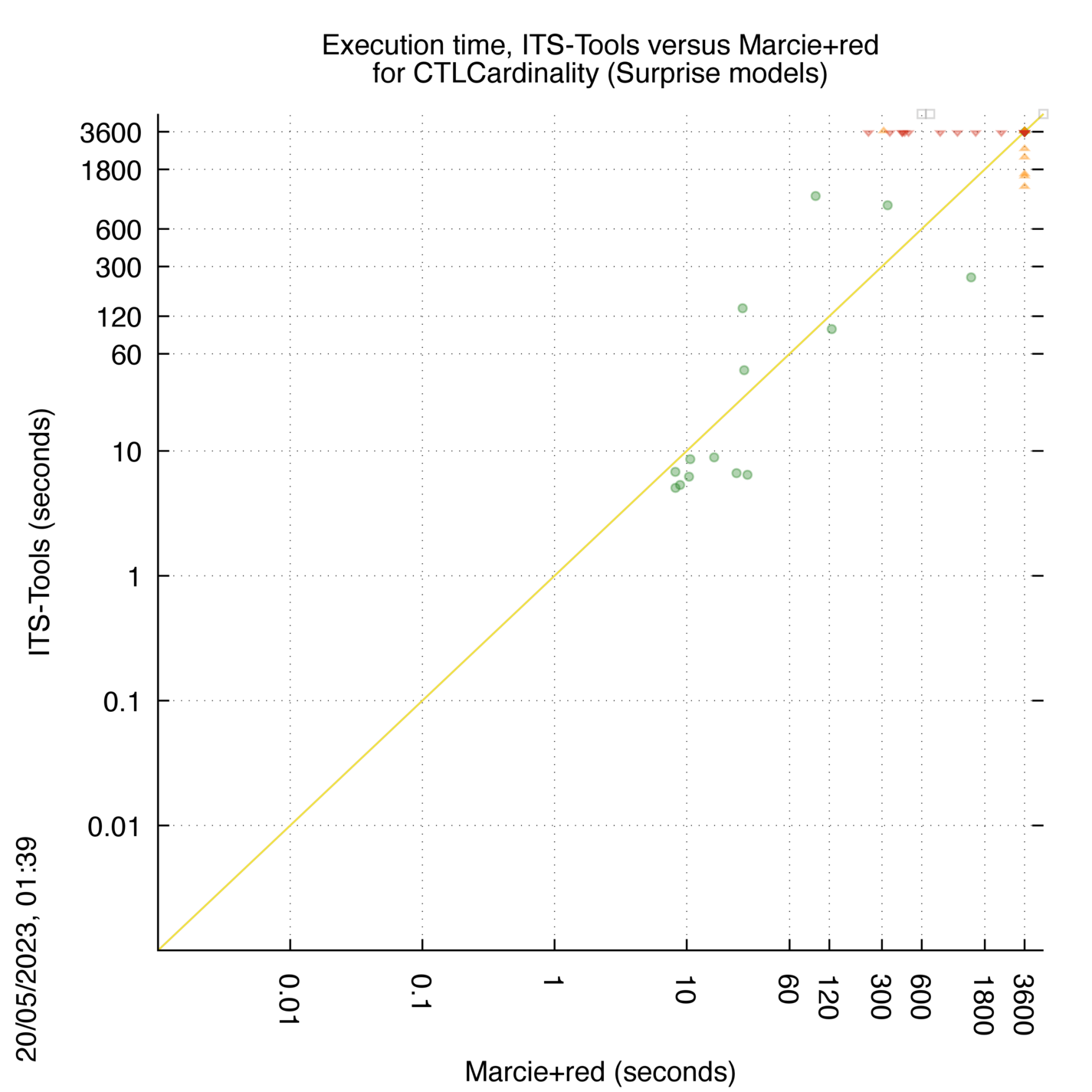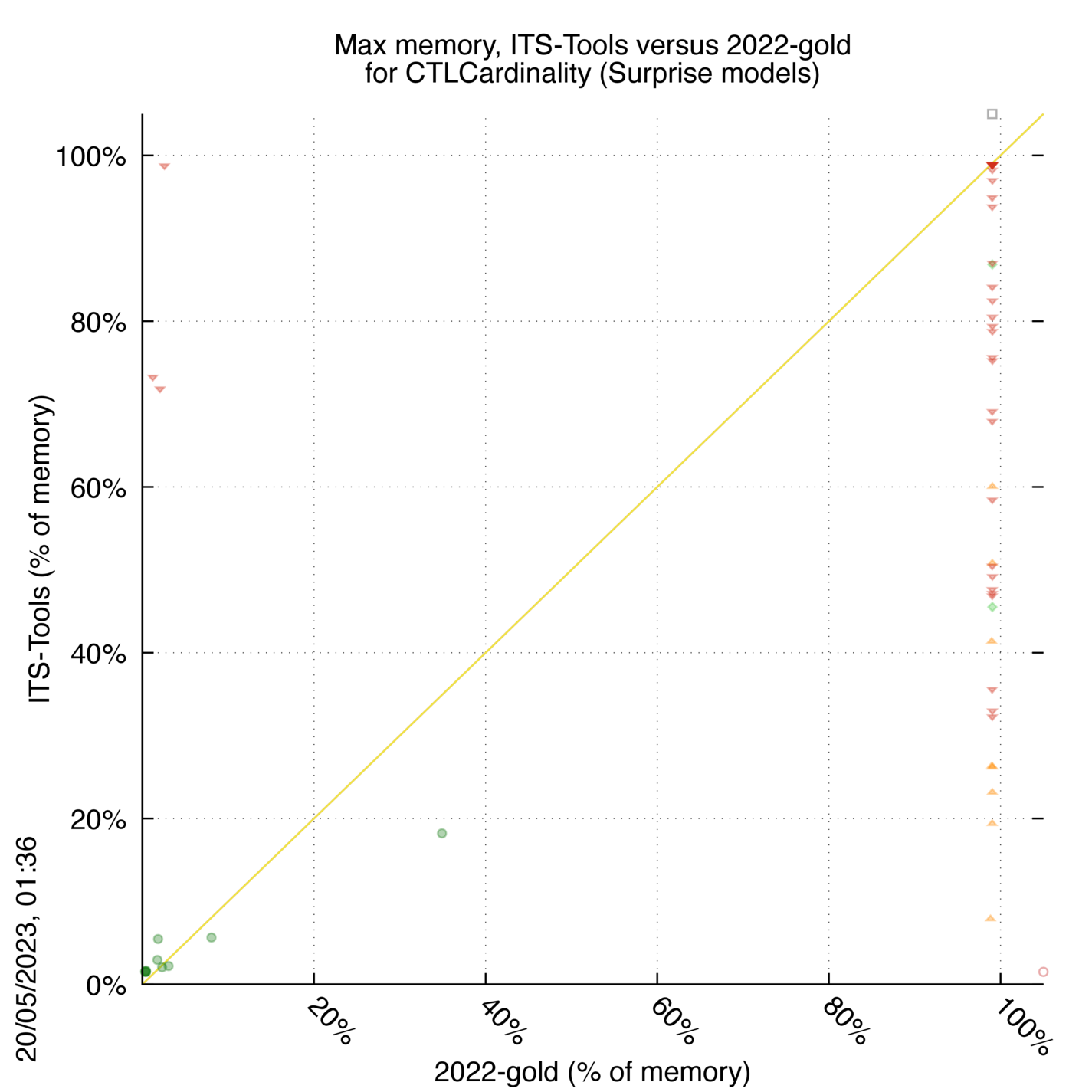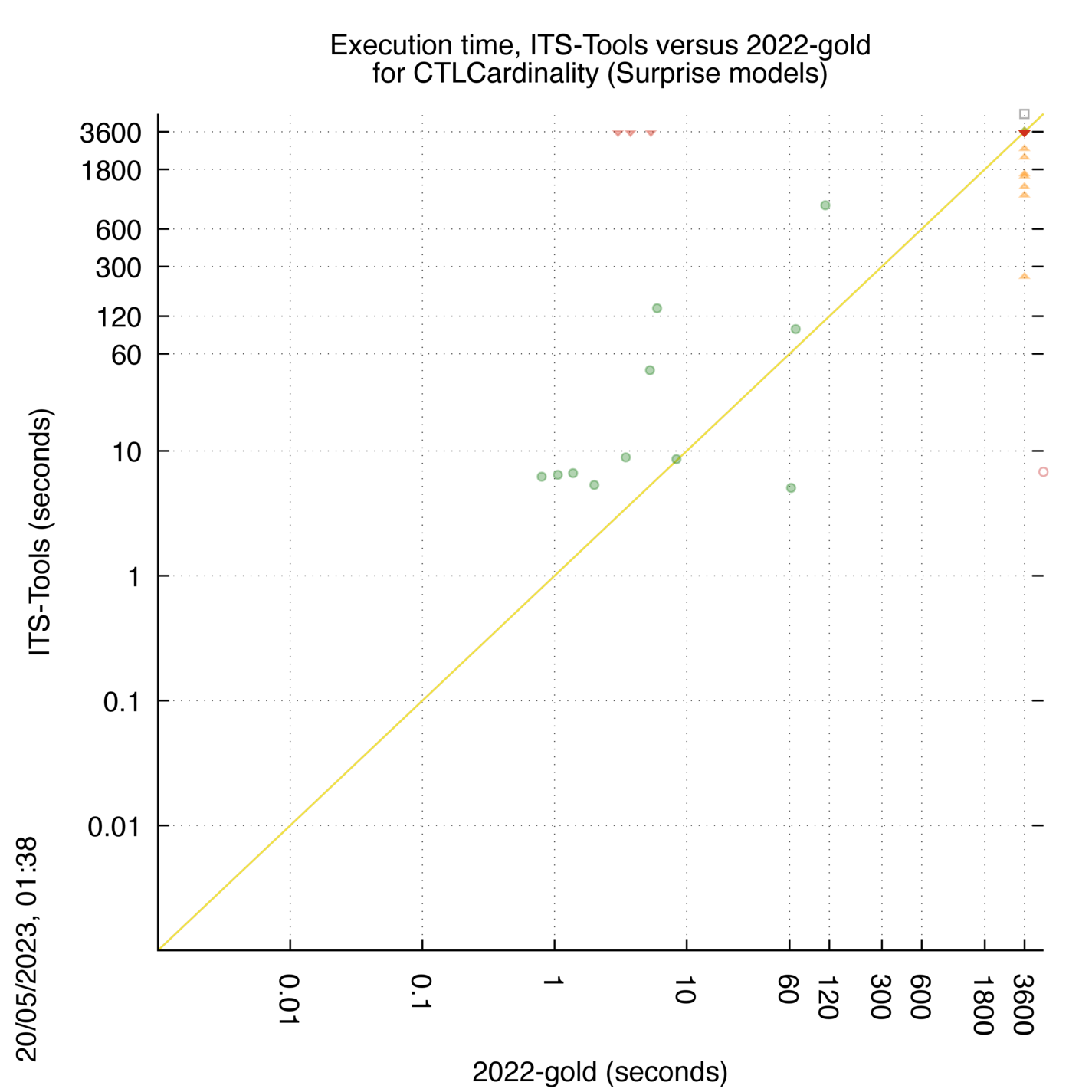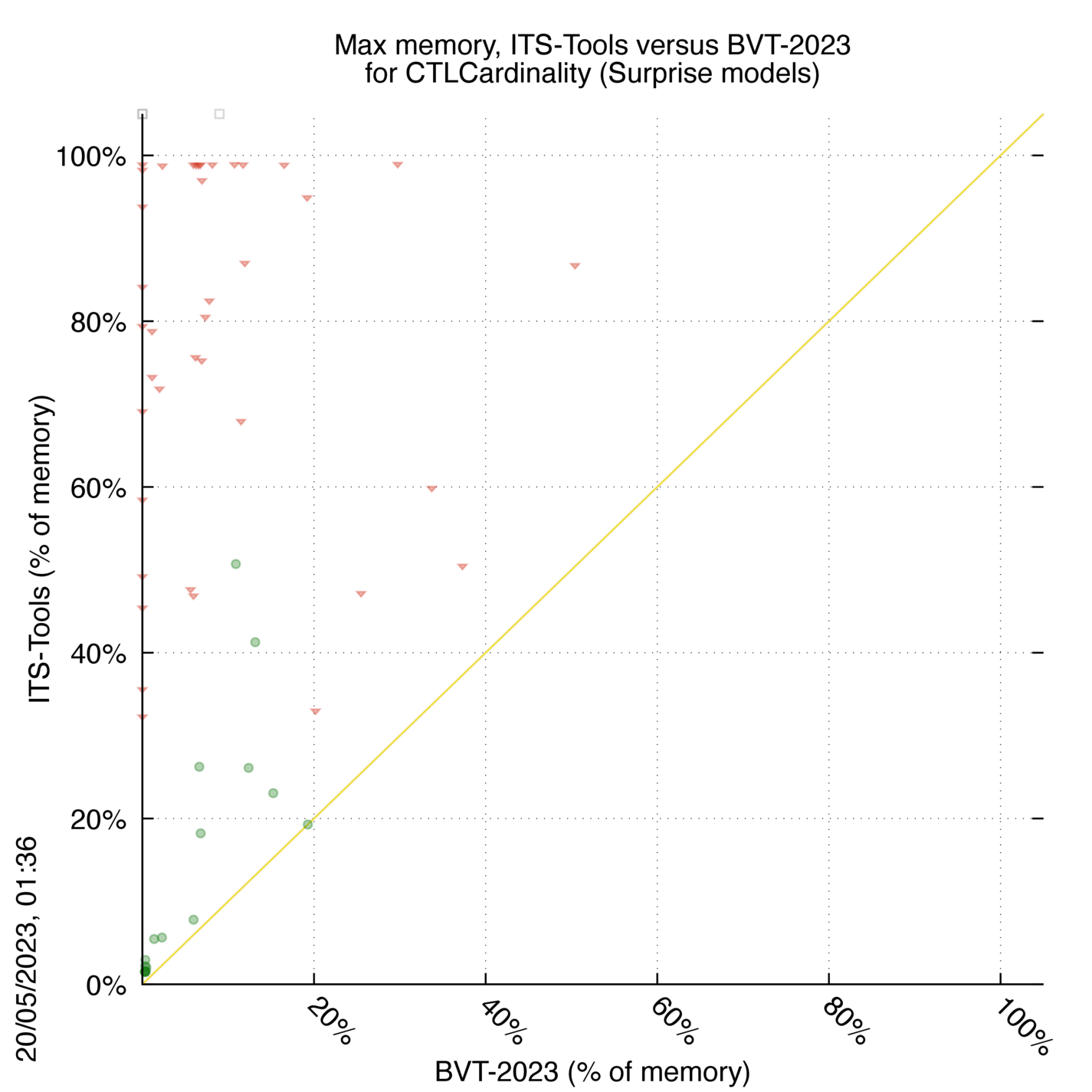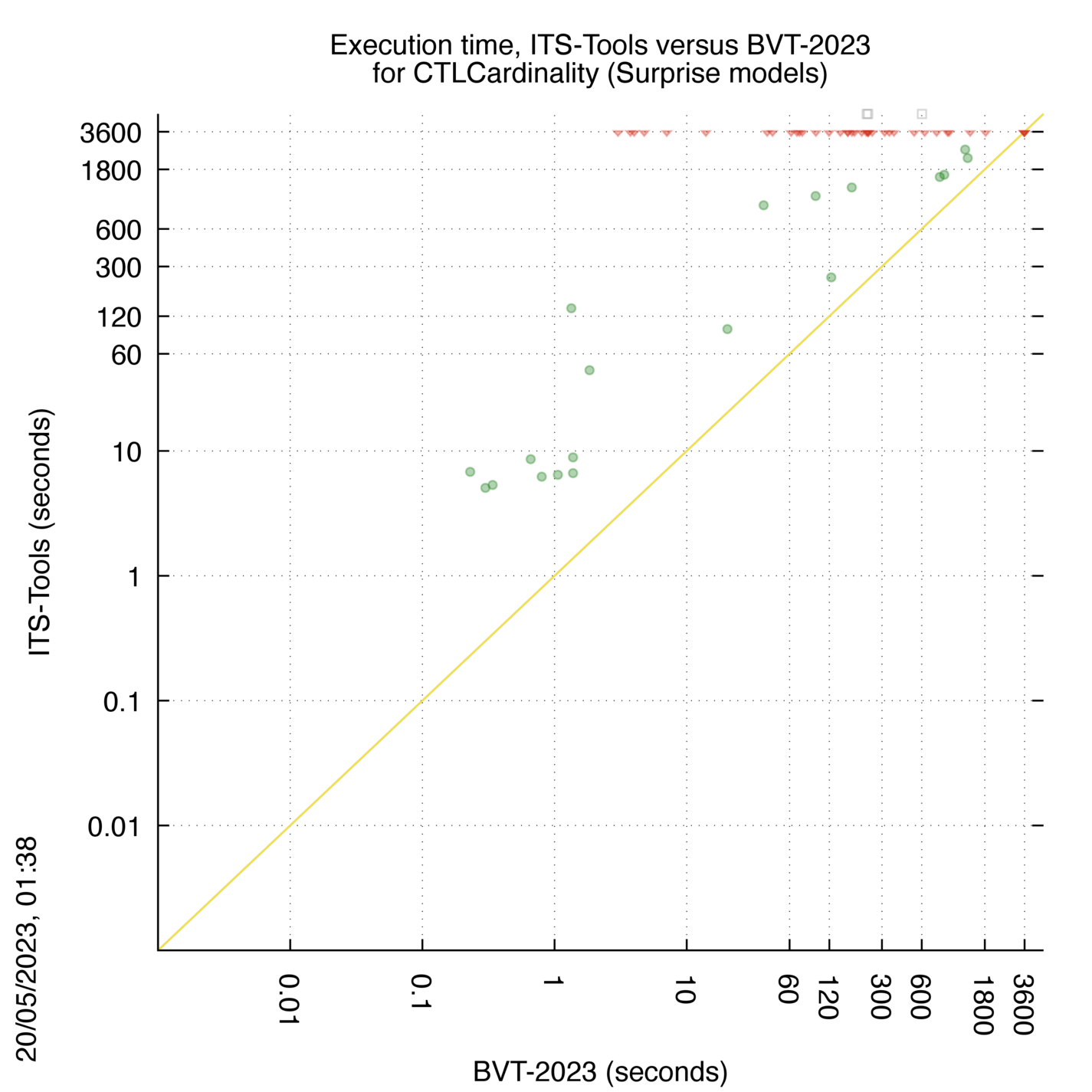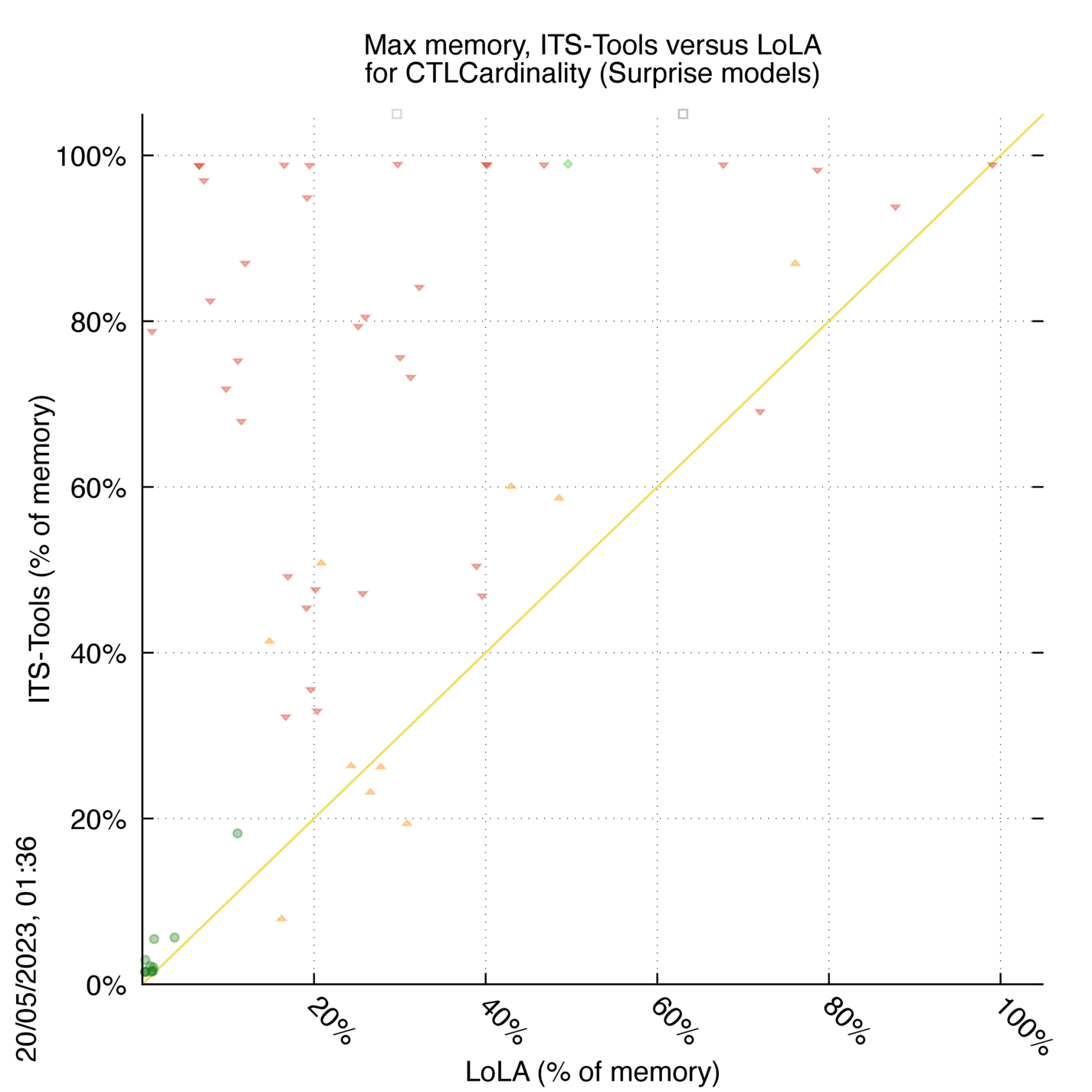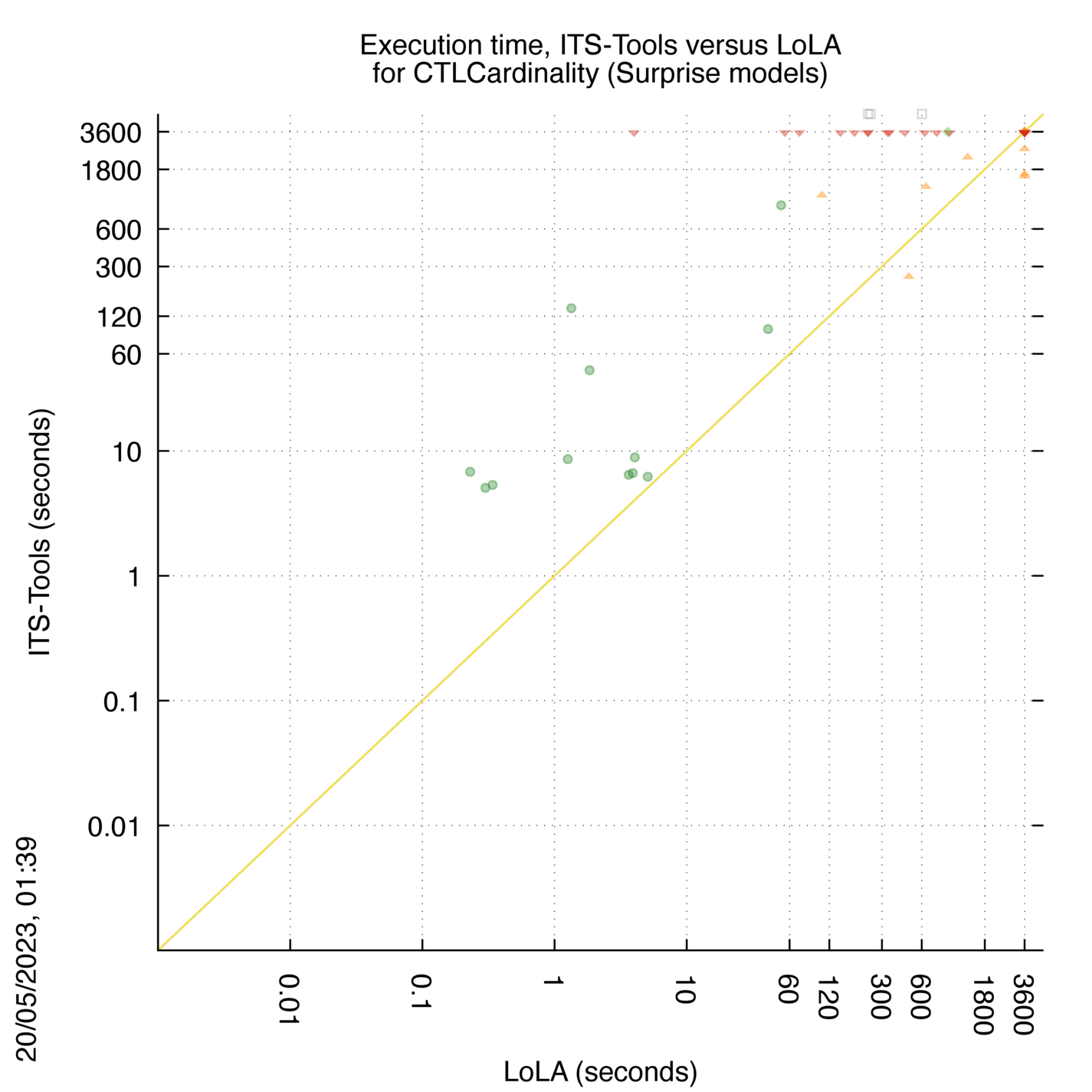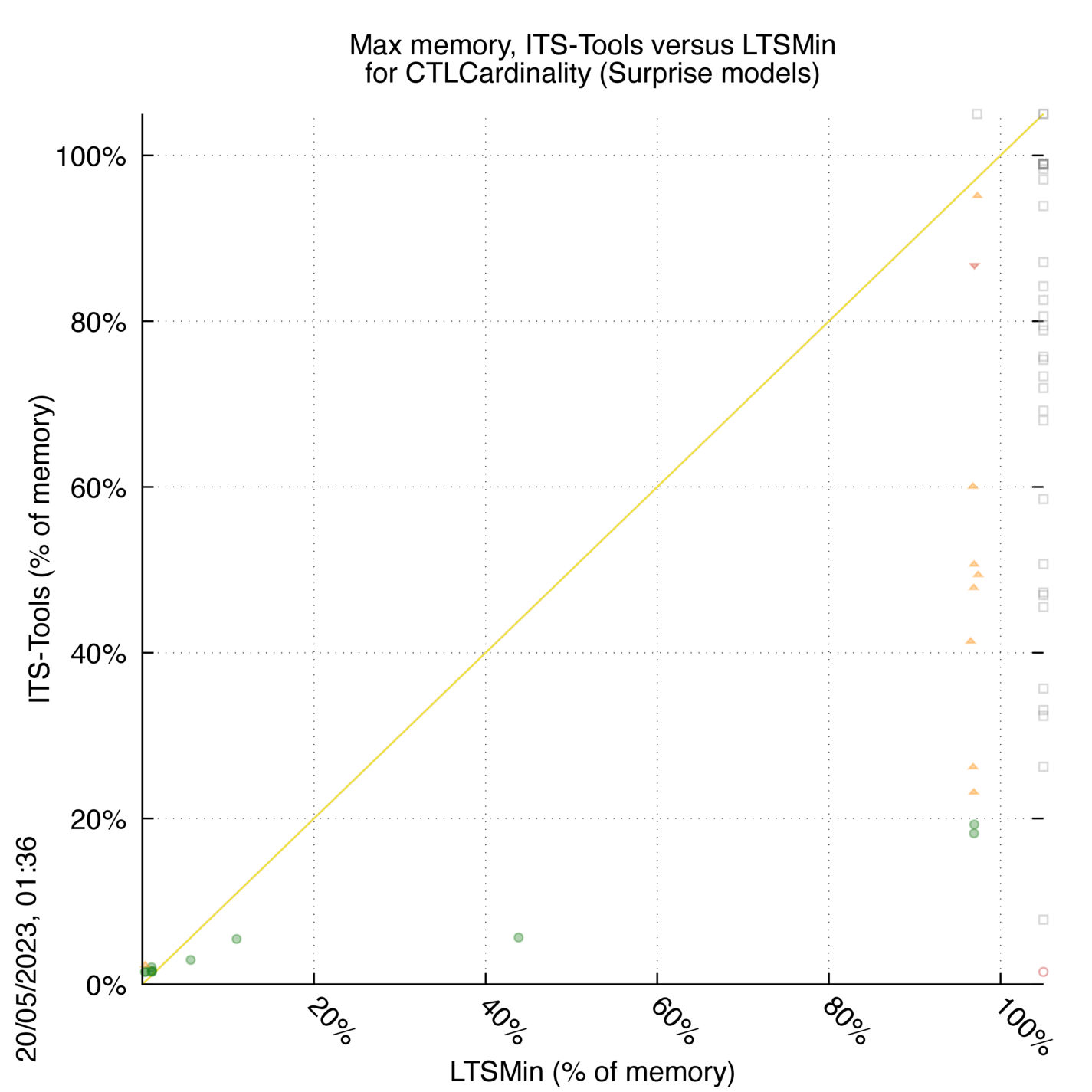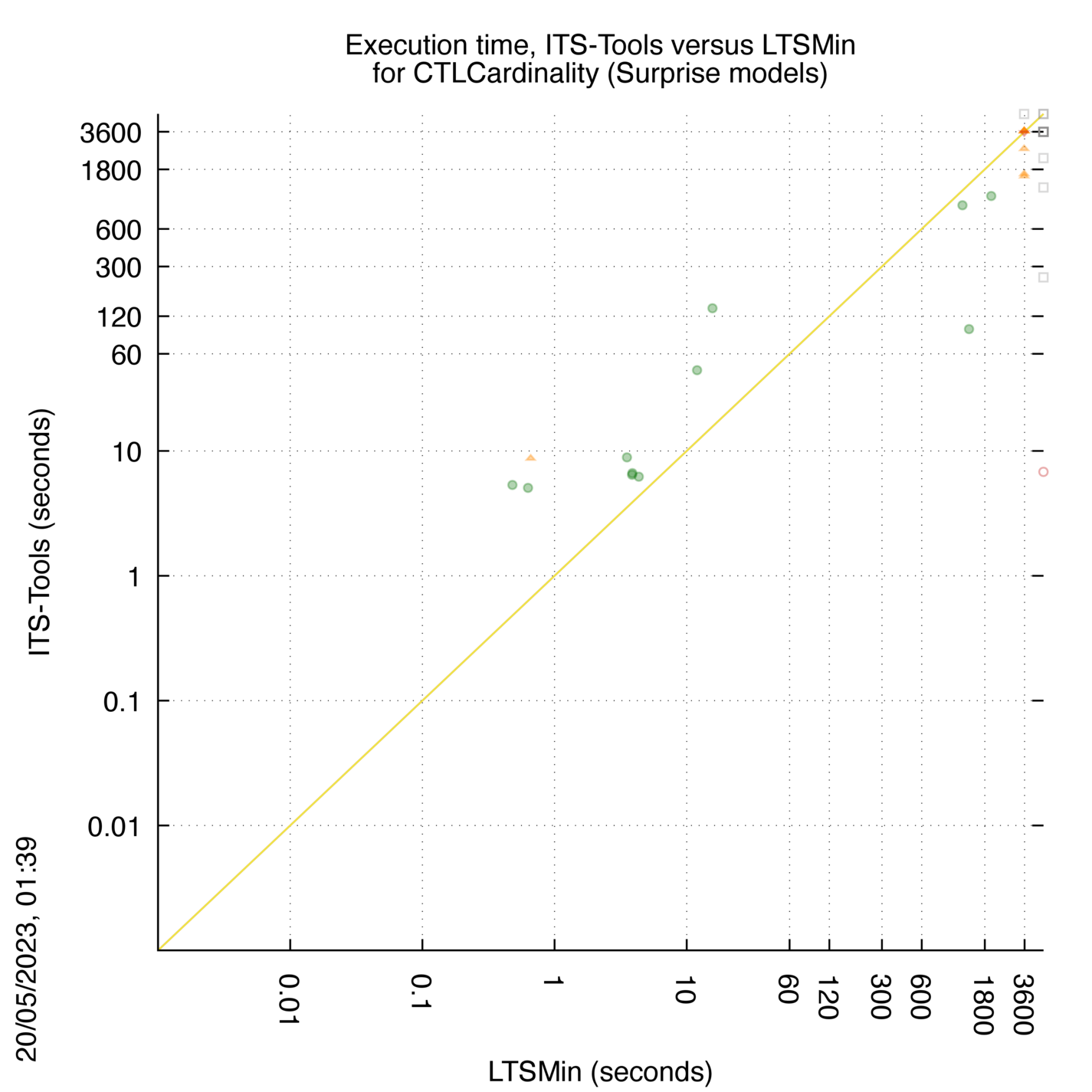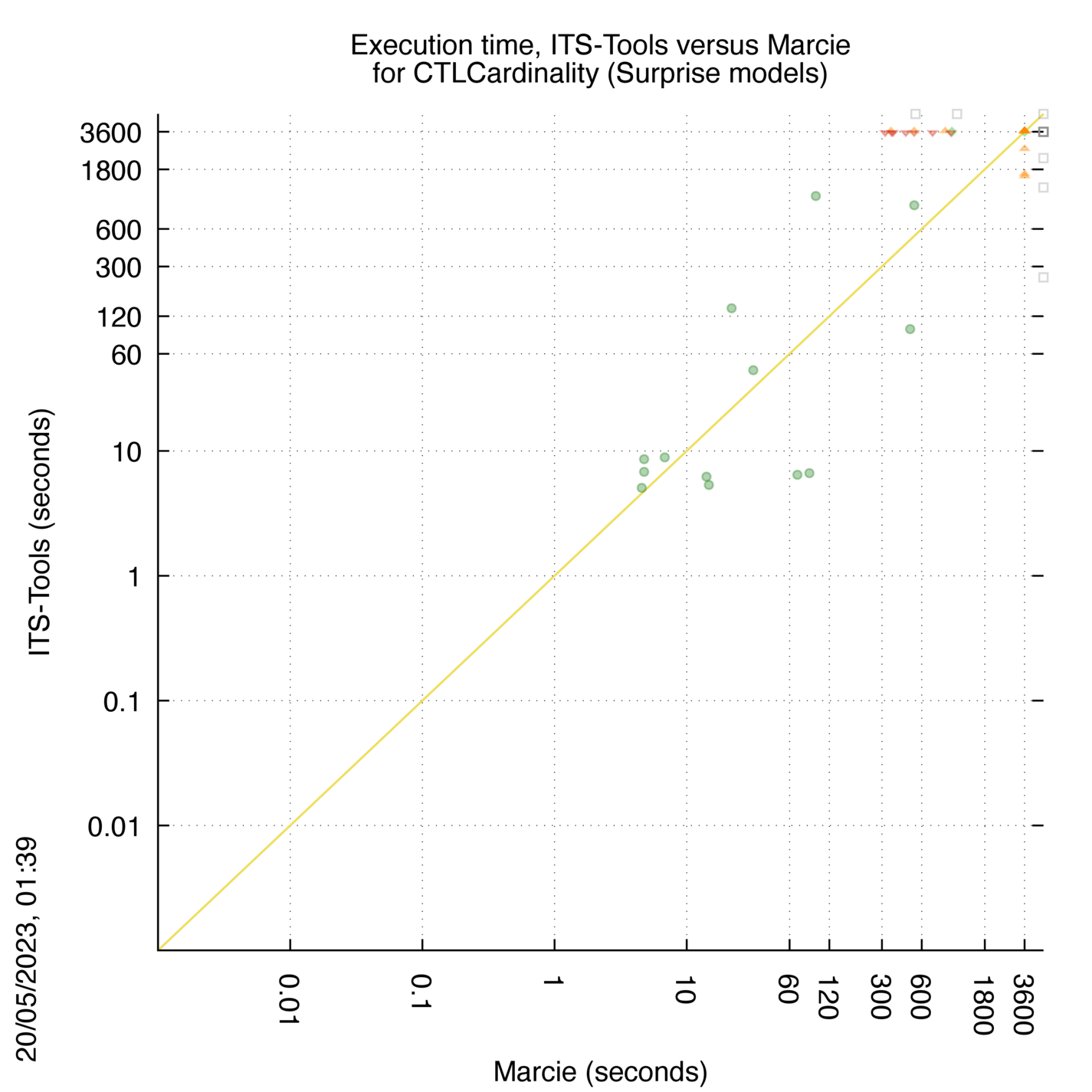Introduction
This page presents how ITS-Tools do cope efficiently with the CTLCardinality examination face to the other participating tools. In this page, we consider «Surprise» models.
The next sections will show chart comparing performances in terms of both memory and execution time.The x-axis corresponds to the challenging tool where the y-axes represents ITS-Tools' performances. Thus, points below the diagonal of a chart denote comparisons favorables to the tool while others corresponds to situations where the challenging tool performs better.
You might also find plots out of the range that denote the case were at least one tool could not answer appropriately (error, time-out, could not compute or did not competed).
ITS-Tools versus GreatSPN
Some statistics are displayed below, based on 122 runs (61 for ITS-Tools and 61 for GreatSPN, so there are 61 plots on each of the two charts). Each execution was allowed 1 hour and 16 GByte of memory. Then performance charts comparing ITS-Tools to GreatSPN are shown (you may click on one graph to enlarge it).
| Statistics on the executions | ||||||
| ITS-Tools | GreatSPN | Both tools | ITS-Tools | GreatSPN | ||
| All computed OK | 22 | 1 | 13 | Smallest Memory Footprint | ||
| ITS-Tools = GreatSPN | — | — | 1 | Times tool wins | 41 | 18 |
| ITS-Tools > GreatSPN | — | — | 11 | Shortest Execution Time | ||
| ITS-Tools < GreatSPN | — | — | 11 | Times tool wins | 24 | 35 |
| Do not compete | 0 | 0 | 0 | |||
| Error detected | 0 | 0 | 0 | |||
| Cannot Compute + Time-out | 1 | 22 | 2 | |||
On the chart below, ![]() denote cases where
the two tools did computed all results without error,
denote cases where
the two tools did computed all results without error,
![]() denote cases where the two tool did computed the
same number of values (but not al values in the examination),
denote cases where the two tool did computed the
same number of values (but not al values in the examination),
![]() denote cases where ITS-Tools
computed more values than GreatSPN,
denote cases where ITS-Tools
computed more values than GreatSPN,
![]() denote cases where ITS-Tools
computed less values than GreatSPN,
denote cases where ITS-Tools
computed less values than GreatSPN,
![]() denote the cases where at least one tool did not competed,
denote the cases where at least one tool did not competed,
![]() denote the cases where at least one
tool computed a bad value and
denote the cases where at least one
tool computed a bad value and ![]() denote the cases where at least one tool stated it could not compute a result or timed-out.
denote the cases where at least one tool stated it could not compute a result or timed-out.
ITS-Tools wins when points are below the diagonal, GreatSPN wins when points are above the diagonal.
ITS-Tools versus Tapaal
Some statistics are displayed below, based on 122 runs (61 for ITS-Tools and 61 for Tapaal, so there are 61 plots on each of the two charts). Each execution was allowed 1 hour and 16 GByte of memory. Then performance charts comparing ITS-Tools to Tapaal are shown (you may click on one graph to enlarge it).
| Statistics on the executions | ||||||
| ITS-Tools | Tapaal | Both tools | ITS-Tools | Tapaal | ||
| All computed OK | 1 | 3 | 11 | Smallest Memory Footprint | ||
| ITS-Tools = Tapaal | — | — | 1 | Times tool wins | 46 | 15 |
| ITS-Tools > Tapaal | — | — | 9 | Shortest Execution Time | ||
| ITS-Tools < Tapaal | — | — | 36 | Times tool wins | 9 | 52 |
| Do not compete | 0 | 0 | 0 | |||
| Error detected | 0 | 1 | 0 | |||
| Cannot Compute + Time-out | 3 | 0 | 0 | |||
On the chart below, ![]() denote cases where
the two tools did computed all results without error,
denote cases where
the two tools did computed all results without error,
![]() denote cases where the two tool did computed the
same number of values (but not al values in the examination),
denote cases where the two tool did computed the
same number of values (but not al values in the examination),
![]() denote cases where ITS-Tools
computed more values than Tapaal,
denote cases where ITS-Tools
computed more values than Tapaal,
![]() denote cases where ITS-Tools
computed less values than Tapaal,
denote cases where ITS-Tools
computed less values than Tapaal,
![]() denote the cases where at least one tool did not competed,
denote the cases where at least one tool did not competed,
![]() denote the cases where at least one
tool computed a bad value and
denote the cases where at least one
tool computed a bad value and ![]() denote the cases where at least one tool stated it could not compute a result or timed-out.
denote the cases where at least one tool stated it could not compute a result or timed-out.
ITS-Tools wins when points are below the diagonal, Tapaal wins when points are above the diagonal.
ITS-Tools versus LoLa+red
Some statistics are displayed below, based on 122 runs (61 for ITS-Tools and 61 for LoLa+red, so there are 61 plots on each of the two charts). Each execution was allowed 1 hour and 16 GByte of memory. Then performance charts comparing ITS-Tools to LoLa+red are shown (you may click on one graph to enlarge it).
| Statistics on the executions | ||||||
| ITS-Tools | LoLa+red | Both tools | ITS-Tools | LoLa+red | ||
| All computed OK | 0 | 3 | 13 | Smallest Memory Footprint | ||
| ITS-Tools = LoLa+red | — | — | 1 | Times tool wins | 4 | 57 |
| ITS-Tools > LoLa+red | — | — | 7 | Shortest Execution Time | ||
| ITS-Tools < LoLa+red | — | — | 37 | Times tool wins | 6 | 55 |
| Do not compete | 0 | 0 | 0 | |||
| Error detected | 0 | 0 | 0 | |||
| Cannot Compute + Time-out | 3 | 0 | 0 | |||
On the chart below, ![]() denote cases where
the two tools did computed all results without error,
denote cases where
the two tools did computed all results without error,
![]() denote cases where the two tool did computed the
same number of values (but not al values in the examination),
denote cases where the two tool did computed the
same number of values (but not al values in the examination),
![]() denote cases where ITS-Tools
computed more values than LoLa+red,
denote cases where ITS-Tools
computed more values than LoLa+red,
![]() denote cases where ITS-Tools
computed less values than LoLa+red,
denote cases where ITS-Tools
computed less values than LoLa+red,
![]() denote the cases where at least one tool did not competed,
denote the cases where at least one tool did not competed,
![]() denote the cases where at least one
tool computed a bad value and
denote the cases where at least one
tool computed a bad value and ![]() denote the cases where at least one tool stated it could not compute a result or timed-out.
denote the cases where at least one tool stated it could not compute a result or timed-out.
ITS-Tools wins when points are below the diagonal, LoLa+red wins when points are above the diagonal.
ITS-Tools versus LTSMin+red
Some statistics are displayed below, based on 122 runs (61 for ITS-Tools and 61 for LTSMin+red, so there are 61 plots on each of the two charts). Each execution was allowed 1 hour and 16 GByte of memory. Then performance charts comparing ITS-Tools to LTSMin+red are shown (you may click on one graph to enlarge it).
| Statistics on the executions | ||||||
| ITS-Tools | LTSMin+red | Both tools | ITS-Tools | LTSMin+red | ||
| All computed OK | 1 | 1 | 13 | Smallest Memory Footprint | ||
| ITS-Tools = LTSMin+red | — | — | 22 | Times tool wins | 29 | 30 |
| ITS-Tools > LTSMin+red | — | — | 21 | Shortest Execution Time | ||
| ITS-Tools < LTSMin+red | — | — | 1 | Times tool wins | 17 | 42 |
| Do not compete | 0 | 0 | 0 | |||
| Error detected | 0 | 0 | 0 | |||
| Cannot Compute + Time-out | 1 | 1 | 2 | |||
On the chart below, ![]() denote cases where
the two tools did computed all results without error,
denote cases where
the two tools did computed all results without error,
![]() denote cases where the two tool did computed the
same number of values (but not al values in the examination),
denote cases where the two tool did computed the
same number of values (but not al values in the examination),
![]() denote cases where ITS-Tools
computed more values than LTSMin+red,
denote cases where ITS-Tools
computed more values than LTSMin+red,
![]() denote cases where ITS-Tools
computed less values than LTSMin+red,
denote cases where ITS-Tools
computed less values than LTSMin+red,
![]() denote the cases where at least one tool did not competed,
denote the cases where at least one tool did not competed,
![]() denote the cases where at least one
tool computed a bad value and
denote the cases where at least one
tool computed a bad value and ![]() denote the cases where at least one tool stated it could not compute a result or timed-out.
denote the cases where at least one tool stated it could not compute a result or timed-out.
ITS-Tools wins when points are below the diagonal, LTSMin+red wins when points are above the diagonal.
ITS-Tools versus Marcie+red
Some statistics are displayed below, based on 122 runs (61 for ITS-Tools and 61 for Marcie+red, so there are 61 plots on each of the two charts). Each execution was allowed 1 hour and 16 GByte of memory. Then performance charts comparing ITS-Tools to Marcie+red are shown (you may click on one graph to enlarge it).
| Statistics on the executions | ||||||
| ITS-Tools | Marcie+red | Both tools | ITS-Tools | Marcie+red | ||
| All computed OK | 0 | 2 | 14 | Smallest Memory Footprint | ||
| ITS-Tools = Marcie+red | — | — | 18 | Times tool wins | 23 | 37 |
| ITS-Tools > Marcie+red | — | — | 10 | Shortest Execution Time | ||
| ITS-Tools < Marcie+red | — | — | 16 | Times tool wins | 15 | 45 |
| Do not compete | 0 | 0 | 0 | |||
| Error detected | 0 | 0 | 0 | |||
| Cannot Compute + Time-out | 2 | 0 | 1 | |||
On the chart below, ![]() denote cases where
the two tools did computed all results without error,
denote cases where
the two tools did computed all results without error,
![]() denote cases where the two tool did computed the
same number of values (but not al values in the examination),
denote cases where the two tool did computed the
same number of values (but not al values in the examination),
![]() denote cases where ITS-Tools
computed more values than Marcie+red,
denote cases where ITS-Tools
computed more values than Marcie+red,
![]() denote cases where ITS-Tools
computed less values than Marcie+red,
denote cases where ITS-Tools
computed less values than Marcie+red,
![]() denote the cases where at least one tool did not competed,
denote the cases where at least one tool did not competed,
![]() denote the cases where at least one
tool computed a bad value and
denote the cases where at least one
tool computed a bad value and ![]() denote the cases where at least one tool stated it could not compute a result or timed-out.
denote the cases where at least one tool stated it could not compute a result or timed-out.
ITS-Tools wins when points are below the diagonal, Marcie+red wins when points are above the diagonal.
ITS-Tools versus 2022-gold
Some statistics are displayed below, based on 122 runs (61 for ITS-Tools and 61 for 2022-gold, so there are 61 plots on each of the two charts). Each execution was allowed 1 hour and 16 GByte of memory. Then performance charts comparing ITS-Tools to 2022-gold are shown (you may click on one graph to enlarge it).
| Statistics on the executions | ||||||
| ITS-Tools | 2022-gold | Both tools | ITS-Tools | 2022-gold | ||
| All computed OK | 1 | 3 | 11 | Smallest Memory Footprint | ||
| ITS-Tools = 2022-gold | — | — | 2 | Times tool wins | 47 | 14 |
| ITS-Tools > 2022-gold | — | — | 8 | Shortest Execution Time | ||
| ITS-Tools < 2022-gold | — | — | 36 | Times tool wins | 9 | 52 |
| Do not compete | 0 | 0 | 0 | |||
| Error detected | 0 | 1 | 0 | |||
| Cannot Compute + Time-out | 3 | 0 | 0 | |||
On the chart below, ![]() denote cases where
the two tools did computed all results without error,
denote cases where
the two tools did computed all results without error,
![]() denote cases where the two tool did computed the
same number of values (but not al values in the examination),
denote cases where the two tool did computed the
same number of values (but not al values in the examination),
![]() denote cases where ITS-Tools
computed more values than 2022-gold,
denote cases where ITS-Tools
computed more values than 2022-gold,
![]() denote cases where ITS-Tools
computed less values than 2022-gold,
denote cases where ITS-Tools
computed less values than 2022-gold,
![]() denote the cases where at least one tool did not competed,
denote the cases where at least one tool did not competed,
![]() denote the cases where at least one
tool computed a bad value and
denote the cases where at least one
tool computed a bad value and ![]() denote the cases where at least one tool stated it could not compute a result or timed-out.
denote the cases where at least one tool stated it could not compute a result or timed-out.
ITS-Tools wins when points are below the diagonal, 2022-gold wins when points are above the diagonal.
ITS-Tools versus BVT-2023
Some statistics are displayed below, based on 122 runs (61 for ITS-Tools and 61 for BVT-2023, so there are 61 plots on each of the two charts). Each execution was allowed 1 hour and 16 GByte of memory. Then performance charts comparing ITS-Tools to BVT-2023 are shown (you may click on one graph to enlarge it).
Important: here, ITS-Tools is compared to BVT-2023. It is a good way to check how ITS-Tools compete in terms of resource consomption with the best tools (even virtual). When ITS-Tools is best, the corresponding plots are on the diagonal of the scatter plots chart.
| Statistics on the executions | ||||||
| ITS-Tools | BVT-2023 | Both tools | ITS-Tools | BVT-2023 | ||
| All computed OK | 0 | 3 | 19 | Smallest Memory Footprint | ||
| ITS-Tools = BVT-2023 | — | — | 0 | Times tool wins | 0 | 61 |
| ITS-Tools > BVT-2023 | — | — | 0 | Shortest Execution Time | ||
| ITS-Tools < BVT-2023 | — | — | 39 | Times tool wins | 0 | 61 |
| Do not compete | 0 | 0 | 0 | |||
| Error detected | 0 | 0 | 0 | |||
| Cannot Compute + Time-out | 3 | 0 | 0 | |||
On the chart below, ![]() denote cases where
the two tools did computed all results without error,
denote cases where
the two tools did computed all results without error,
![]() denote cases where the two tool did computed the
same number of values (but not al values in the examination),
denote cases where the two tool did computed the
same number of values (but not al values in the examination),
![]() denote cases where ITS-Tools
computed more values than BVT-2023,
denote cases where ITS-Tools
computed more values than BVT-2023,
![]() denote cases where ITS-Tools
computed less values than BVT-2023,
denote cases where ITS-Tools
computed less values than BVT-2023,
![]() denote the cases where at least one tool did not competed,
denote the cases where at least one tool did not competed,
![]() denote the cases where at least one
tool computed a bad value and
denote the cases where at least one
tool computed a bad value and ![]() denote the cases where at least one tool stated it could not compute a result or timed-out.
denote the cases where at least one tool stated it could not compute a result or timed-out.
ITS-Tools wins when points are below the diagonal, BVT-2023 wins when points are above the diagonal.
ITS-Tools versus LoLA
Some statistics are displayed below, based on 122 runs (61 for ITS-Tools and 61 for LoLA, so there are 61 plots on each of the two charts). Each execution was allowed 1 hour and 16 GByte of memory. Then performance charts comparing ITS-Tools to LoLA are shown (you may click on one graph to enlarge it).
| Statistics on the executions | ||||||
| ITS-Tools | LoLA | Both tools | ITS-Tools | LoLA | ||
| All computed OK | 0 | 3 | 12 | Smallest Memory Footprint | ||
| ITS-Tools = LoLA | — | — | 1 | Times tool wins | 6 | 55 |
| ITS-Tools > LoLA | — | — | 10 | Shortest Execution Time | ||
| ITS-Tools < LoLA | — | — | 35 | Times tool wins | 4 | 57 |
| Do not compete | 0 | 0 | 0 | |||
| Error detected | 0 | 0 | 0 | |||
| Cannot Compute + Time-out | 3 | 0 | 0 | |||
On the chart below, ![]() denote cases where
the two tools did computed all results without error,
denote cases where
the two tools did computed all results without error,
![]() denote cases where the two tool did computed the
same number of values (but not al values in the examination),
denote cases where the two tool did computed the
same number of values (but not al values in the examination),
![]() denote cases where ITS-Tools
computed more values than LoLA,
denote cases where ITS-Tools
computed more values than LoLA,
![]() denote cases where ITS-Tools
computed less values than LoLA,
denote cases where ITS-Tools
computed less values than LoLA,
![]() denote the cases where at least one tool did not competed,
denote the cases where at least one tool did not competed,
![]() denote the cases where at least one
tool computed a bad value and
denote the cases where at least one
tool computed a bad value and ![]() denote the cases where at least one tool stated it could not compute a result or timed-out.
denote the cases where at least one tool stated it could not compute a result or timed-out.
ITS-Tools wins when points are below the diagonal, LoLA wins when points are above the diagonal.
ITS-Tools versus LTSMin
Some statistics are displayed below, based on 122 runs (61 for ITS-Tools and 61 for LTSMin, so there are 61 plots on each of the two charts). Each execution was allowed 1 hour and 16 GByte of memory. Then performance charts comparing ITS-Tools to LTSMin are shown (you may click on one graph to enlarge it).
| Statistics on the executions | ||||||
| ITS-Tools | LTSMin | Both tools | ITS-Tools | LTSMin | ||
| All computed OK | 37 | 1 | 11 | Smallest Memory Footprint | ||
| ITS-Tools = LTSMin | — | — | 0 | Times tool wins | 51 | 8 |
| ITS-Tools > LTSMin | — | — | 9 | Shortest Execution Time | ||
| ITS-Tools < LTSMin | — | — | 1 | Times tool wins | 43 | 16 |
| Do not compete | 0 | 0 | 0 | |||
| Error detected | 0 | 1 | 0 | |||
| Cannot Compute + Time-out | 1 | 36 | 2 | |||
On the chart below, ![]() denote cases where
the two tools did computed all results without error,
denote cases where
the two tools did computed all results without error,
![]() denote cases where the two tool did computed the
same number of values (but not al values in the examination),
denote cases where the two tool did computed the
same number of values (but not al values in the examination),
![]() denote cases where ITS-Tools
computed more values than LTSMin,
denote cases where ITS-Tools
computed more values than LTSMin,
![]() denote cases where ITS-Tools
computed less values than LTSMin,
denote cases where ITS-Tools
computed less values than LTSMin,
![]() denote the cases where at least one tool did not competed,
denote the cases where at least one tool did not competed,
![]() denote the cases where at least one
tool computed a bad value and
denote the cases where at least one
tool computed a bad value and ![]() denote the cases where at least one tool stated it could not compute a result or timed-out.
denote the cases where at least one tool stated it could not compute a result or timed-out.
ITS-Tools wins when points are below the diagonal, LTSMin wins when points are above the diagonal.
ITS-Tools versus Marcie
Some statistics are displayed below, based on 122 runs (61 for ITS-Tools and 61 for Marcie, so there are 61 plots on each of the two charts). Each execution was allowed 1 hour and 16 GByte of memory. Then performance charts comparing ITS-Tools to Marcie are shown (you may click on one graph to enlarge it).
| Statistics on the executions | ||||||
| ITS-Tools | Marcie | Both tools | ITS-Tools | Marcie | ||
| All computed OK | 19 | 2 | 13 | Smallest Memory Footprint | ||
| ITS-Tools = Marcie | — | — | 2 | Times tool wins | 41 | 19 |
| ITS-Tools > Marcie | — | — | 17 | Shortest Execution Time | ||
| ITS-Tools < Marcie | — | — | 7 | Times tool wins | 27 | 33 |
| Do not compete | 0 | 0 | 0 | |||
| Error detected | 0 | 0 | 0 | |||
| Cannot Compute + Time-out | 2 | 19 | 1 | |||
On the chart below, ![]() denote cases where
the two tools did computed all results without error,
denote cases where
the two tools did computed all results without error,
![]() denote cases where the two tool did computed the
same number of values (but not al values in the examination),
denote cases where the two tool did computed the
same number of values (but not al values in the examination),
![]() denote cases where ITS-Tools
computed more values than Marcie,
denote cases where ITS-Tools
computed more values than Marcie,
![]() denote cases where ITS-Tools
computed less values than Marcie,
denote cases where ITS-Tools
computed less values than Marcie,
![]() denote the cases where at least one tool did not competed,
denote the cases where at least one tool did not competed,
![]() denote the cases where at least one
tool computed a bad value and
denote the cases where at least one
tool computed a bad value and ![]() denote the cases where at least one tool stated it could not compute a result or timed-out.
denote the cases where at least one tool stated it could not compute a result or timed-out.
ITS-Tools wins when points are below the diagonal, Marcie wins when points are above the diagonal.


